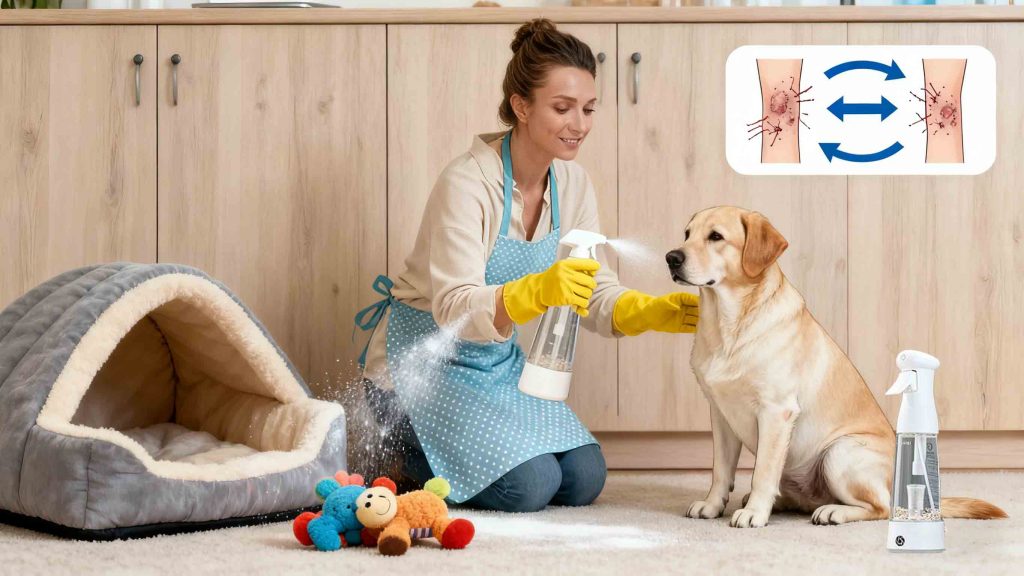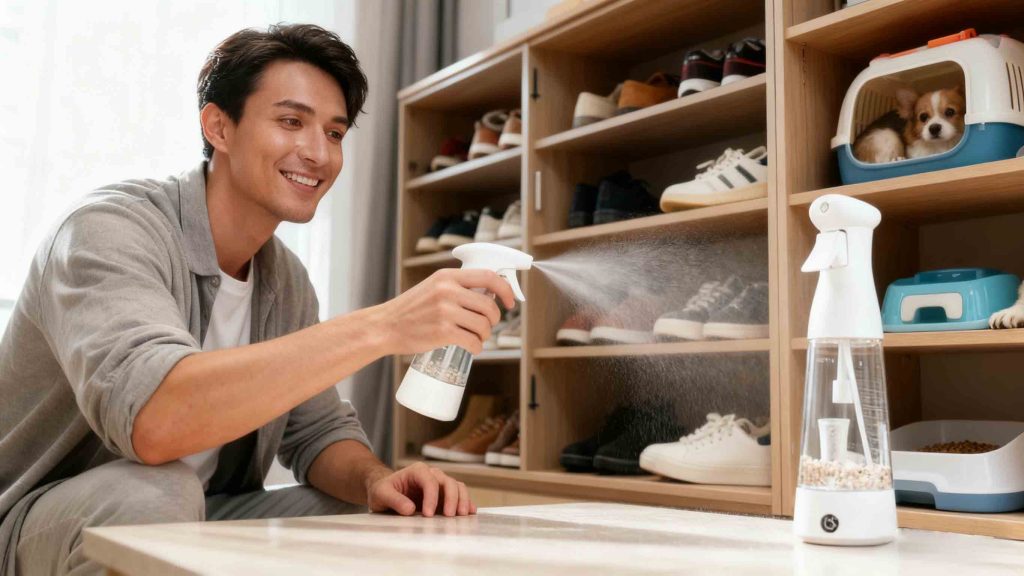Globally, dermatophyte infections affect about 20-25% of the population, of which Trichophyton mentagrophytes (T. mentagrophytes) and Trichophyton rubrum (T. rubrum) are the main pathogens. These two fungi are not only highly contagious, but can also survive for a long time in humid environments, posing many challenges to our health and quality of life. According to data from the journal Medical Mycology in 2023, these two fungi together account for 62% of clinical dermatophyte infections.
This article will take you to an in-depth understanding of the characteristics, hazards, transmission routes and prevention methods of T. mentagrophytes, and also introduce how to easily deal with fungal threats and protect family health through the efficient and environmentally friendly ARGENTUMIX silver ion generator.
What is Trichophyton Mentagrophytes?
Trichophyton mentagrophytes, is an animal-loving dermatophyte belonging to the genus Trichophyton of the phylum Ascomycota, which can infect humans and a variety of animals.
Key Characteristics:
1. Microscopic characteristics:
· The hyphae are slender and transparent, and can produce a large number of spherical or pear-shaped microconidia (aggregated in the shape of grapes). Macroconidia are rare and are rod-shaped.
2. Reproduction method:
· Asexual reproduction is the main method, which is transmitted through conidia, and can also be multiplied by hyphae breakage. Sexual reproduction is rare in nature.
3. Structural characteristics:
· The cell wall contains chitin, which can secrete keratinase and lipase to help decompose the host’s stratum corneum to obtain nutrients.
4. Symbiosis:
· Facultative parasitism, can survive for a short period of time in animal fur or humid environments, and rodents are often asymptomatic carriers.
5. Resistance:
· strong survival ability and can survive for months in soil, clothing, and pet bed pads.
· resistant to dryness and low temperature (survives at 4°C), and is resistant to conventional disinfectants.
· sensitive to high temperature (>60°C) and alcohol, and needs to be completely killed by using chlorine-containing disinfectants (such as sodium hypochlorite) or ultraviolet irradiation.
6. Pathogenic characteristics:
· It invades the skin, hair and nails, causing erythema, desquamation or blisters, such as athlete’s foot, tinea corporis and onychomycosis.
7. Pathogenic conditions:
· It requires a humid environment, damaged skin or low immunity (such as diabetes) to successfully infect.

Hazards of Trichophyton Mentagrophytes
1. Causes Dermatophytosis (Fungal Skin Infections)
· Keratin degradation: The fungus feeds on keratin in the skin, secreting keratinase to break down the skin barrier, leading to erythema, scaling, and blisters.
· Common infection sites: Thrives in moist, poorly ventilated areas (e.g., feet, groin), causing athlete’s foot (tinea pedis) and jock itch (tinea cruris).
2. Chronic Infections & Skin Damage
· Recurrent outbreaks: Incomplete treatment allows dormant fungal spores to reactivate, causing repeated infections.
· Secondary bacterial infections: Damaged skin is vulnerable to Staphylococcus aureus, leading to pus formation or cellulitis.
3. High Contagiousness
· Direct transmission: Spreads through skin contact with infected humans or animals.
· Indirect transmission: Via shared towels, socks, gym equipment, or contaminated damp surfaces (e.g., public showers).
4. Onychomycosis (Nail Fungus)
· Nail damage: Invades nails, causing thickening, discoloration (yellow/white), brittleness, or even nail loss.
· Prolonged treatment: Dense nail structure hinders drug penetration, requiring months of therapy.
5. Drug Resistance Issues
· Antifungal misuse: Overuse of drugs (e.g., terbinafine) may enhance fungal resistance.
· Biofilm formation: Fungi develop protective biofilms on skin/nails, reducing drug effectiveness.
6. Foul Odor Problems
· Fungal metabolites: Releases sulfur/nitrogen-containing compounds during keratin breakdown, producing rotten or musty smells.
· Bacterial co-infections: Bacteria (e.g., Corynebacterium, Staphylococcus) thrive in moist areas, generating isovaleric acid (cheesy odor) or hydrogen sulfide (rotten egg smell).
· Infected skin environment: Chronic infections cause thickened, eroded skin with necrotic tissue and microbial buildup, worsening odor. Occlusive footwear traps sweat, fermenting into pungent odors.
7. Zoonotic Transmission Risk
· Pet-to-human spread: Infected cats, dogs, or rodents can transmit the fungus via close contact (e.g., petting, sharing beds), creating a human-animal infection cycle.
Common Scenarios and Transmission Routes
1. Common breeding scenarios
· Personal items: shoes and socks (not breathable), undried towels/bath towels, tight clothing, razors, nail clippers.
· Public facilities: bathroom floors, swimming pool locker rooms, gym equipment, sports protective gear, helmet liners, nail tools.
· Pet-related: fur of sick pets, pet bed mats, and combing tools.
· Home environment: wet areas such as carpets and bathroom anti-slip mats.
2. Transmission routes
· Direct contact: scratching the affected area and then touching other parts of the body, contact with the affected skin of an infected person or sick animal.
· Indirect contact: sharing contaminated items or touching contaminated surfaces, shoes and socks and clothing that are not thoroughly cleaned.
· Environmental factors promote: warm and humid environments reproduce quickly, and damaged skin barriers are easily invaded by fungi.
Preventive measures
1. Personal hygiene
· Keep the skin dry, especially in susceptible areas such as the feet and groin.
· Avoid sharing personal items such as towels, shoes, socks, and nail clippers.
2. Environmental cleaning
· Regularly disinfect the home environment (such as bathrooms, carpets) and public places (such as gyms).
· Regularly clean and disinfect items and tools.
3. Pet management
· Regularly check the skin health of pets and avoid close contact with sick animals.
· Clean and disinfect pet beds and grooming tools.
4. Standardized treatment
· See a doctor in time when symptoms appear, and avoid abusing antifungal drugs.
· Adhere to a full course of treatment to prevent recurrence and drug resistance.

Innovative solution: ARGENTUMIX silver ion technology
Traditional chemical disinfection methods such as chlorine-containing disinfectants or glutaraldehyde or hydrogen peroxide have a high efficiency in reducing T. mentagrophytes, but there are problems such as odor irritation, skin irritation and chemical residues.
The ARGENTUMIX silver ion generator provides an innovative solution for home fungus prevention and control with its safety, environmental protection and high efficiency. Through electrolysis, 1-3ppm silver ion sterilization solution can be produced by tap water. Silver ions (Ag⁺) have broad-spectrum antibacterial properties. They destroy microbial cell membranes, interfere with enzyme activity and DNA replication, cause protein denaturation and cell death, and thus kill bacteria efficiently. They have a significant sterilization effect on T. mentagrophytes.
According to CNAS-certified lab tests (Report No. 2024SP08890R04), a 1 ppm silver ion solution achieves a 99% reduce rate against Trichophyton mentagrophytes (CGMCC 3.598) in 10 minutes (per WS/T 650-2019, 5.2.1). [See Test Report]
Through the simple combination of “a machine + tap water”, ARGENTUMIX silver ion generator can not only effectively reduce pathogenic microorganisms such as T. mentagrophytes, but also reduce the burden of chemical disinfectants and plastic packaging on the environment and human body, truly practicing the healthy living concept of “reducing the burden on the earth”.
Prevention Over Cure.
Pay attention to the details of daily cleaning, take precautions before it happens, and destroy its reproduction conditions – keep dry, maintain the balance of bacterial flora, scientifically disinfect, stay away from fungal infections, and enjoy a healthy and comfortable life.
If you want to know the application of silver ion technology in other scenarios (such as home environment, maternal and child products, and pet disinfection), you can [click here] to get more relevant information.
Note: Silver ion technology (such as ARGENTUMIX silver ion generator) is suitable for daily cleaning and disinfection, and assists in reducing the risk of infection, but it cannot replace drug treatment. If the infection has been confirmed, please follow the doctor’s advice for standardized treatment, and cooperate with environmental disinfection (such as soaking the affected area in contact with objects) to block the spread.